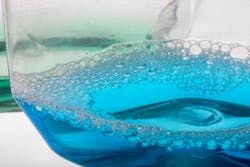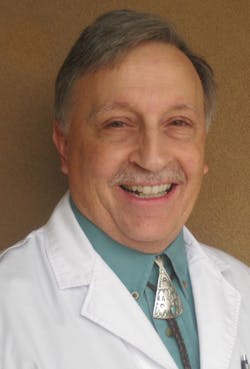Antimicrobial mouthwash: The potential downside
There exist hundreds of different species of microorganisms in the oral biofilm. The vast majority are commensal and not pathological.1 These commensal microbes have specifically evolved with the human species, and many have benefits for the host species. To date, research has only discovered a relative handful of these benefits.
A study, recently published in the journal Free Radical Biology and Medicine, has questioned the potential deleterious impact of antibiotic mouthwashes.2 Researchers evaluated consequences of reduced beneficial nitrite-producing oral bacteria postexercise. Subsequent to acute physical exercise, postexercise hypotension is generally induced. This can play an important role in lowering blood pressure and chronic hypertension. Unfortunately, there exists little exact physiological understanding of the mechanisms in play.
This double-blind crossover study recorded blood pressure on 23 human subjects, both one hour and two hours after moderate-intensity treadmill workouts. Blood and salivary nitrite levels were also recorded. Participants in the research received either antimicrobial mouthwash or a placebo at the prescribed time intervals. Subjects not receiving antimicrobial mouthwash demonstrated a significantly reduced systolic blood pressure.
The authors concluded that nitrite synthesis by oral bacteria positively induces a vascular response to promote lowered blood pressure and elevated muscle oxygenation. By contrast, destruction of oral commensal bacteria by an antibiotic mouth rinse may negate the positive impact of lowered blood pressure after exercise.3
Seemingly, this was a well-designed study. However, the limited sample size of test subjects precludes one from jumping to immediate definitive conclusions.
The antiseptic mouthwash industry represents a huge and growing international market.4 Numbers of factors are driving this growth inclusive of expanding disposable per capita income, awareness of the importance of dental care, ease of use, recognition of halitosis, and recommendations from dental care providers. Sales in the mouthwash industry for the US alone represent many hundreds of millions of dollars per year.5 The global market in 2018 was $2,860 million and is expected to rise to $4,430 million by the end of 2025.6
Mouthwash products are marketed to a variety of specific consumer demands. These include addressing bad breath and gingivitis, arresting dental caries, and promoting tooth whitening. Currently, many of these products have a broad range of sepsis upon microbes in the biofilm. Yet, many of these oral microorganisms have beneficial effects on their host, most of which have not been discovered.
We are only now uncovering the vital role of gut bacteria in support of human well-being and health.7,8 We know far less about the impact of the oral biofilm, which has coevolved with humans for hundreds of thousands of years.
References
1. Berger D, Rakhamimova A, Pollack A, Loewy Z. Oral biofilms: development, control, and analysis. High-Throughput. 2018;7(3):24. doi:10.3390/ht7030024.
2. Cutler C, Kiernan M, Willis JR, et al. Post-exercise hypotension and skeletal muscle oxygenation is regulated by nitrate-reducing activity of oral bacteria. Free Radic Biol Med. 2019;143:252-259. doi:10.1016/j.freeradbiomed.2019.07.035.
3. Meszaros L. Here’s why you may want to skip the mouthwash. MDLinx website. https://www.mdlinx.com/internal-medicine/article/4452. Published September 17, 2019.
4. Antiseptic mouthwash market - global industry analysis, size, share, growth, trends and forecast 2017-2025. Transparency Market Research website. https://www.transparencymarketresearch.com/antiseptic-mouthwash-market.html.
5. Sales of the leading mouthwash/dental rinse brands in the United States in 2018. Statista website. https://www.statista.com/statistics/195543/sales-of-leading-us-mouthwash-brands-in-2012-and-2013/. Published 2019.
6. Global mouthwash market 2019 – industry analysis, size, share, strategies and forecast to 2025 [news release]. Pune, India: MarketersMedia; March 7, 2019. https://www.marketwatch.com/press-release/global-mouthwash-market-2019-industry-analysis-size-share-strategies-and-forecast-to-2025-2019-03-07.
7. Galland L. The gut microbiome and the brain. J Med Food. 2014;17(12):1261-1272. doi:10.1089/jmf.2014.7000.
8. Wang H, Wei C-X, Min L, Zhu L-Y. Good or bad: gut bacteria in human health and diseases. Biotechnol Biotechnol Equip. 2018;32(5):1075-1080. doi:10.1080/13102818.2018.1481350.
Editor’s note: This article originally appeared in Perio-Implant Advisory, a chairside resource for dentists and dental hygienists for issues relating to periodontal and implant medicine. Exclusive content from an academic perspective centers on complex care, solving clinical complications from a team-based approach through interdisciplinary management.
About the Author
Michael W. Davis, DDS
Michael W. Davis, DDS, maintains a general dental practice in Santa Fe, New Mexico. He is active with legal expert review for dental malpractice and fraud cases. Dr. Davis also serves as chair for his district dental society peer review and delegate to the New Mexico Dental Association for policy and legislative issues. Contact him at [email protected] or http://www.smilesofsantafe.com/.


